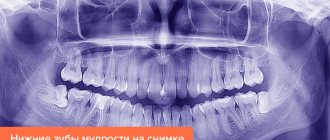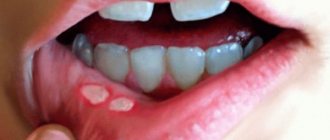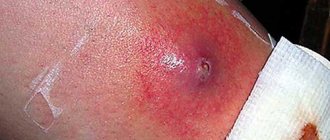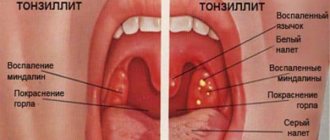Characteristics of the pathology
This disease is an inflammatory process in the dental pulp. Inflammation can develop if caries treatment is not carried out in a timely manner. The disease begins to progress and eventually affects internal tissues.
In pregnant women, the situation is complicated by hormonal imbalances and a constant lack of minerals and trace elements in the body. The main role here is played by a lack of calcium, due to which the skeletal system is formed and maintained. In this case, not only the pain syndrome, which significantly complicates the life of the expectant mother, is important, but also the detrimental effect of the inflammatory process on the child in the womb.
It is possible and even necessary to treat the pulp in this condition. If the situation is left to chance, a progressive infection can cause significant harm, and only timely intervention by a dentist will help avoid serious problems and numerous complications.
Remember, a pregnant woman should take any medications (analgesics) only after consulting a doctor.
Causes
Inflammation provoked by infectious agents progresses in the form of focal lesions. Often it affects not only the enamel layer of the tooth, but also its neurovascular system.
The disease can occur in acute or chronic form. It develops as a consequence of deep advanced caries. Therefore, a woman should consult a specialist already at the time of planning motherhood. After all, in a short period of pregnancy, even in the 1st trimester of pregnancy, pulpitis is already a serious problem, which is much more difficult for an expectant mother to solve than for an ordinary patient. Treatment of a diseased pulp will be significantly more complicated due to its condition.
How quickly the pathology will progress depends on a number of factors, including: the individual characteristics of the body, how long ago the first symptoms appeared.
The rate of development of the disease can also be affected by:
- decreased immunity;
- lack of calcium, magnesium, phosphorus.
Symptoms
The inflammatory process develops quickly, leading to a rapid deterioration in well-being. Its pronounced manifestations are:
- severe pain, most often manifested at night;
- high tooth sensitivity when eating cold or hot food;
- increased body temperature, which in some cases can reach 38°C.
Experiencing unremitting pain, the expectant mother is in a constant state of stress. At the same time, the body releases hormonal substances, which is very unsafe for the baby in the womb.
How dangerous is the disease for mother and fetus?
It is wrong to postpone treatment of pulpitis during pregnancy. A constant source of infection in the mouth is a risk of complications for the fetus. Inflammation of the pulp leads to the release of toxins and bacteria into the blood, which enter the child’s body through the placenta. Constant pain provokes emotional stress and nervous tension, which is bad for a pregnant woman. Pulpitis leads to the following complications:
- periodontitis (inflammation of the gums around the tooth and tooth roots);
- osteomyelitis (purulent abscess inside the jaw);
- periostitis , better known as gumboil (pain in the periosteum of the tooth);
- abscess (purulent inflammation inside the tooth).
Acute pulpitis without timely treatment becomes chronic. This leads to the development of a permanent focus of infection in the oral cavity.
When the abscess is advanced, the inflammatory process spreads to the entire jaw.
Is it possible to treat pulpitis during pregnancy?
Despite the woman’s delicate position, therapy is necessary. And this needs to be done quickly. A rapidly progressing infection will cause much more harm than the medications used in treatment.
Most pregnant women are mistaken in believing that eliminating pathology is contraindicated for them. Moreover, dentists themselves some time ago did not recommend therapy for expectant mothers. The main fears that arise when medical intervention is necessary are the following prejudices:
- the likelihood of miscarriage or premature birth;
- fear of using anesthesia that is dangerous for the baby in the womb;
- the involvement of arsenic in eliminating the nerve;
- negative effects of x-rays (take a picture if necessary);
- anxiety when using a reflective lamp during therapy (known to many as “blue”).
All these worries are completely unfounded. When treating an inflamed pulp in an expectant mother, Dentik must take into account the biological features of its position.
Therefore, even in the 2nd and 3rd trimester of pregnancy, pulpitis can be cured. It is important to first consult with a gynecologist who is observing the woman. And when visiting the dental office, the first thing you should do is tell the doctor about your condition.
What are the difficulties of therapeutic intervention?
During this period, all medical procedures are carried out on a smaller scale. During the process, the pregnant woman should not experience pain. The best time to solve dental problems is 3-6 months of gestation. At this point, the placental protection has already been formed; accordingly, the baby is completely protected from the negative influence of foreign substances (medicines).
If the pathology manifests itself in a given time period, there is no need to refuse therapy. It is necessary to contact a specialist and eliminate the problem in order to avoid possible complications due to the development of infection.
When figuring out how to treat pulpitis on teeth during pregnancy, it is worth knowing that doctors do this as carefully as possible. They try not to cause pain to the patient and use only safe drugs. Treatment and filling of dental canals is carried out using completely harmless materials.
It is better to carry out all medical procedures in relation to the expectant mother without anesthesia. If this is not possible, for example, when removing a nerve, dentists use non-adrenaline compounds for pain relief.
Exposing a woman to x-rays is also extremely undesirable. However, if necessary, photographs are still taken, using modern equipment and observing all the necessary safety measures.
When contacting a specialist, a pregnant woman is obliged to notify him of the exact date of her condition, describe her state of health and tell him about the presence of allergic reactions to medications.
Medical devices and medications of the latest generation minimize the negative impact on the body of mother and baby. Therefore, treating dental diseases is not only possible, but also necessary. Of course, ideally, it is better to prevent the occurrence of a disease by solving emerging problems in a timely manner.
Myths about the treatment of pulpitis during pregnancy
Women are afraid to have dental treatment during pregnancy due to various misconceptions. They all boil down to the fact that drugs, radiation from equipment and treatment itself can harm the fetus.
However, it is not. All prejudices turn out to be unfounded:
- Myth number one: tooth pain will go away on its own. Painful sensations in acute pulpitis are difficult to relieve even with analgesics. The situation is different with a chronic form of pathology: symptoms can either increase or subside. But inflammation and the infectious process continue to develop.
- Myth two: X-rays are harmful to the embryo. The effect of x-rays used in dentistry is local. In addition, modern equipment - visiographs - reduce exposure to radiation to a minimum.
- Myth three: arsenic causes fetal pathologies. This substance is truly toxic and has a teratogenic effect that disrupts embryonic development. However, today doctors use arsenic-free pastes to necrotize the nerve. But even applying a small amount of the product to the pulp cannot seriously affect the child.
- Myth number four: Curing lamps emit ultraviolet rays. This equipment is used when installing photocurable fillings. But it is harmless: the installed filter cuts off all radiation except blue radiation, which is absolutely harmless.
Modern equipment and drugs make it possible to treat teeth safely for the woman and fetus.
What are the dangers of untreated pulpitis?
As has been said many times above, therapy is necessary. This is due to the following factors:
- During the period of gestation, a woman’s immune system becomes unstable, immunity weakens, which contributes to the rapid development of pathology.
- To prevent the spread of infection and stop the inflammatory process, the acute phase of the disease must be eliminated. An inflamed pulp is a source of infectious agents that affect the entire body. In advanced cases, even blood poisoning cannot be ruled out.
- If harmful microorganisms enter the gastrointestinal tract, preeclampsia may occur - severe toxicosis in the later stages of pregnancy.
- In some cases, eliminating complications is impossible without the use of antibiotics, which is very undesirable for the expectant mother.
- If you consult a dentist in a timely manner, the nerve will not be removed. Therefore, the use of medications (anesthesia) is excluded.
- When treatment for pulpitis on teeth in pregnant women is not carried out, the infection begins to spread and affects the periodontium, which invariably leads to an inflammatory process at the root (periodontitis). When neglected, there is a high probability of removal.
- An untreated disease leads to suppuration inside the gums. This is how periostitis (flux) appears.
An incorrectly selected therapeutic technique can also provoke serious complications. But at Dentik you can be sure that dentists are prescribed the procedures indicated for them or medications that are safe for the health of the mother and the condition of the child.
Effect on the fetus
It is not for nothing that doctors recommend therapy for pulp disease even during pregnancy. Exposure to X-rays and drugs, while undesirable, is not as harmful as the risk of infection to an unborn baby. Lack of timely treatment can lead to a number of dangerous consequences:
- Inflammation acts as a source of infectious agents. Toxic substances and harmful microorganisms penetrate a woman’s blood, creating a risk of infection of the gestating fetus.
- The psychological state of the expectant mother is no less important, since the baby directly depends on her emotional mood, and intense pain can lead to the release of hormones.
- The use of anesthetics is not recommended in the first trimester, as the drugs may contribute to developmental abnormalities in the child.
- The bodies of mother and baby are closely interconnected. A diseased tooth, which spreads infection, poses a serious threat to both.
Impact on maternal health
For the woman herself, refusal to undergo therapy is no less dangerous. Putting off fixing the problem until later is the wrong decision.
An inflamed pulp not only causes constant pain and stress, but also leads to:
- development of periodontitis;
- suppuration in the gums;
- the appearance of flux;
- abscess.
The acute phase of the disease eventually turns into chronic. A constant source of infectious agents appears in the oral cavity, affecting the entire body.
Pulpitis in pregnant women: treatment features
Despite the fact that modern dentistry uses safe methods to treat pulpitis, the treatment of this disease in pregnant women still has its own characteristics:
- All procedures are performed to the minimum, strictly necessary extent. The main goal of treatment is to eliminate the acute phase of inflammation and relieve pain. Definitive treatment is often carried out after birth.
- Timely initiation of treatment for pulpitis is also important for ordinary patients, but during pregnancy it is of key importance. Due to decreased immunity during pregnancy, pulpitis develops quickly and in the shortest possible time can lead to the development of purulent complications and other dangerous consequences. That is why, if you experience the slightest pain or discomfort, you should immediately seek advice from a dentist.
- The use of anesthesia during pregnancy should be strictly limited, since many painkillers have a negative effect on the functioning of the cardiovascular system. If pain relief is necessary, it is recommended to use drugs with a milder, gentler effect.
When you visit your doctor for the first time, you should provide information about your due date, any known allergic reactions to medications, and whether you have had dental treatment previously during this pregnancy. This will allow you to choose the right treatment tactics and avoid the development of complications.
To prevent inflammatory processes in the gums, use high-quality hygiene products. If your teeth need additional minerals, use Asepta Plus remineralization toothpaste.
How pregnant women are treated for pulpitis
When eliminating dental problems while a woman is carrying a child, doctors follow the established rules. In order for the therapeutic process to be as effective and safe as possible, the specialist needs to know everything about the expectant mother.
During your first visit to the dentist, you must inform him about your condition, indicate the timing and tell him how the pregnancy is progressing. Also, tell your doctor if you have any allergies to medications.
Complete information will help you choose the optimal treatment method.
There are several distinctive features of pulp therapy in pregnant women:
- In the first trimester, experts do not recommend it, since at this time the formation of the baby’s organs occurs. On the third, its implementation is undesirable due to the approaching birth.
- However, in critical situations, therapeutic intervention is mandatory. Treatment of pulpitis may be required up to 35 weeks of pregnancy and can be carried out even after this period.
- At the time of pregnancy, preference is given to installing temporary fillings made of harmless materials. After childbirth, permanent filling is performed.
- The need for pain relief is determined individually. The use of drugs, of course, is undesirable, but during such a crucial period of life, women’s pain threshold decreases. In this case, it is not always possible to do without anesthetics.
- To completely get rid of the disease, it is necessary to eliminate the inflammatory process. To do this, dentists use biological and surgical methods.
- The second method involves removing the outer part of the pulp or its entirety, if it is no longer possible to save the root area.
- Depulpation involves the use of a special composition (without arsenic). This pulp solvent is placed inside the tooth and then filled (temporarily). After a certain time, the nerve is removed, the dental canals are cleaned and a permanent filling is placed.
What anesthesia is acceptable
When treating pulpitis in pregnant women, adrenaline-free anesthetics are used. They act locally and have a gentle effect. Such products are recommended for use with allergy sufferers, as well as women with heart and endocrine system problems.
Ideally, pain relief should be carried out after 13 weeks of gestation. But if necessary, the use of safe drugs at an earlier period is allowed.
The use of painkillers is relevant:
- if the therapeutic process involves drilling before filling;
- when it is necessary to remove a nerve or a tooth itself;
- if necessary, pulp surgery.
Anesthetics based on articaine are quite widespread. They do not harm the fetus because they do not penetrate the placental protection. Vasoconstrictor components are present in them in minimal quantities. Lidocaine and novocaine are also used. In some cases, paracetamol and ibuprofen are acceptable (except for late pregnancy).
Anesthetics are used to temporarily relieve pain and reduce sensitivity. This allows pregnant women not to feel anxiety and pain. Pain syndrome leads to a stressful state in the expectant mother. Stress has an extremely negative effect on a child’s development. Thus, mild anesthesia causes much less harm than painful manifestations and the infection that provokes them.
Effect on the fetus
It is not for nothing that dentists insist that treatment of pulpitis in pregnant women cannot be delayed. The influence of x-ray radiation and anesthesia, although undesirable during this period, is less dangerous than the risk of infection of the unborn child:
- the inflamed pulp becomes a source of infection, from which toxins and pathogens enter the mother’s circulatory system, risking infecting the fetus,
- The emotional mood of the mother has a strong influence on the condition and intrauterine development of the child. His health may suffer due to the effects of hormones released during severe pain from pulpitis,
- the use of anesthesia in the treatment of pulpitis in the first trimester of pregnancy is dangerous because deviations in the intrauterine development of the child are possible,
- a problematic tooth is a breeding ground for infections that can affect the body of a newborn baby, because they have constant close contact with their mother.
Prevention
She should pay attention at the stage of planning motherhood. It is very important to eliminate existing dental problems in a timely manner. Every woman needs to visit a specialist’s office for treatment of damaged teeth.
To avoid undesirable consequences, you should:
- carry out regular oral care;
- carry out preventive measures to prevent the occurrence of caries;
- eat right, including foods rich in calcium, phosphorus, and magnesium in your daily menu.
At the first alarming symptoms, you should immediately consult a doctor. Remember that at the initial stage of development, eliminating the disease is not at all difficult.










